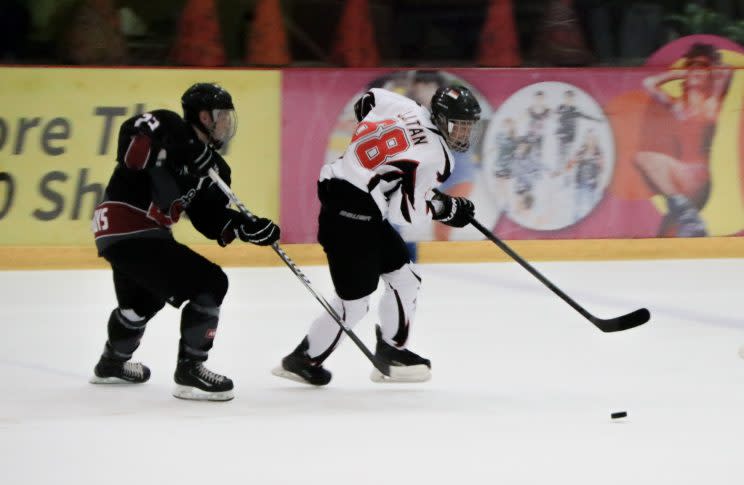Singapore’s ice hockey players pay a high price in order to grow sport

For 15 years since it was founded in 2001, the Singapore Ice Hockey Association (SIHA) has not enjoyed much recognition. But that may change this year, if SIHA has their way.
For the first time ever, the Singapore national men’s ice hockey team is slated to participate in two additional competitions – the Asian Winter Games (AWG) in Sapporo, Japan, in February, and the Southeast Asian Games (SEA Games) in Kuala Lumpur, Malaysia in August.
The team usually competes at the yearly International Ice Hockey Federation (IIHF) Challenge Cup of Asia, which will be held in Kuwait this March.
Unranked in the IIHF world rankings, the team is not expected to clinch a podium finish. Still, they are looking to spring a surprise or two, said captain Michael Loh.
Loh, 41, has been part of the national team since it was formed in 2008 and has 20 years of playing experience. While he acknowledged that Singapore is still behind its peers in the sport, he feels that the gap is closing.
In the AWG, Singapore is grouped in Division I, the second tier behind the Top Division which consists of top ranked countries in Asia. Only the United Arab Emirates is ranked in Division 1, which also consists of Hong Kong, Chinese Taipei, Malaysia and Thailand.
“All these countries, we’ve played them before,” Loh said. “Our margin of defeats over the years go by, it’s getting smaller. All I can say is that for every game, we will do our best to spring a surprise.”
His thoughts were echoed by Ryan Tan, the youngest member of the team at 17.
“I recognise that there are definitely challenges, but I find that there [is] no fear. We just have to skate harder, play harder, be smarter and work better together as a team,” the Raffles Institution student said.
“If we can do that, I don’t see why we cannot take on the stronger opponents.”

Preparation for the upcoming tournaments is proving to be challenging though.
There is only one ice rink – The Rink at JCube – available for training and friendly matches.
Players have to share time on the ice with not just the public, but also two other sports – figure skating and short track speed skating.
The team also pays for rink rental fees out of its own pocket. It costs up to $1,250 per hour to rent the rink at a prime time slot, and $520 per hour after 10pm.
In order to save costs, the players train regularly into midnight five to six times a week, sacrificing sleep time. It is not an easy task, given that most hold full-time jobs, or are still studying.
“We are doing as much as we can,” SIHA president Alphonsus Joseph told Yahoo Singapore. “It’s always hard to find ice time and we can only do it at indecent hours.
“It has become normal… Next day, everyone has to go to work, but it’s just part of the sacrifice for being in the national team.”
An opportunity to grow the sport
SIHA views 2017 as the best opportunity to bring awareness and grow the sport in Singapore.
The association is also hoping that their participation in more tournaments this year will attract more sponsors and donors.

Currently, it operates with a yearly budget of about $750,000 according to Joseph. About $700,000 is spent on expenses for ‘ice time’ and a bulk of this cost is funded by the players. Only $15,000 to $20,000 is spent on the national team programme.
When the team travels overseas, players pay for their own air tickets, and sometimes accommodation. While Loh says the players love the sport enough to fund their own training, Joseph pointed out that a few players have dropped out due to financial struggles.
“A couple of guys would have loved to play in the AWG but budget is always an issue. We try to get some donations to cover some of the costs, but if we can’t, it means they can’t go,” Joseph explained.
Both Sport Singapore and the Singapore National Olympic Council (SNOC) do not provide funding, but support the team through other means. Sport Singapore provides medical coverage for the players in case of injury, while the SNOC provides apparel for the team.
Joseph knows that in order for funding from both Sport Singapore and SNOC to be a reality, the team has to first perform well.
“To be honest the team needs to prove themselves first before we can actually start asking for additional funding,” he said. “Right now, we are still considered an unknown.”

Developing the next generation
Joseph also hopes that the spotlight on ice hockey this year will translate into support for the sport too.
“As much as we can, we will try to make use of these three major tournaments to try and get as much publicity to the sport and hopefully, recruit in more Singaporeans to play,” he said.
With a number of the players in the national team in their late thirties or early forties, SIHA also hopes to attract the next generation of players.
Currently, the only way into the sport is via the skating programmes jointly provided by The Rink and SIHA.
The SIHA have also recently set up a national youth team, and the team will be participating in a South East Asian youth cup in Malaysia in January.
Beyond this initiative, Joseph hopes that more schools will also pick up the sport.
“The Rink is working with a couple of schools, we are trying to approach a couple of schools and work together to get them interested in playing the sport,” Joseph said.
“Having entry into the schools will be a dream. That ‘s where the sustainability of having an ice hockey team will happen. That’s where it leads to a lot more things,” he said.




